- Have any questions?
- 1800 70 90 88
- info@redknight.com.au
Any Inquiries Please Call 1800 70 90 88
Bees & Wasps
People have always found it difficult to differentiate between bees, wasps and hornets. While these insects may have many common traits, such as their yellow and black striped bodies, they are very different from each other and should be quickly identified so that the most effective pest control methods can be employed to eradicate the problem. This is especially important if you are allergic to a bee, hornet or wasp sting, as an allergic reaction can sometimes proof to be fatal. At Redknight our staff are trained to in all kinds of pest control services and can be counted upon to solve any bee related problems.
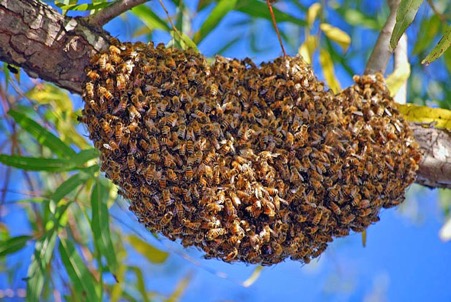
Swarm of Honey bees
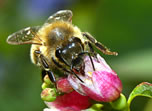
Honey Bee
Identification
Honey Bees are introduced insects. They are dark brown with yellow bands on the abdomen. Their legs are hairy and the eyes also have hairs on them. These social insects live in large colonies.
Size:13-15mm
Habitat: Urban areas, forests and woodlands, heath.
Food: feeds on nectar and pollen
Notes
Honey Bees defend their nest aggressively. The bee dies after stinging, as the sting is left in the victim, tearing out part of the bee abdomen. The sting, with venom gland pumping, is left in. Honey Bee stings cause intense local pain and swelling, and some people have severe allergic reaction.

EUROPEAN WASP & ENGLISH WASP FACTS
Identification
The European Wasp is a social insect with bold black and yellow bands. The black bands have arrow-shaped black markings down the centre of the abdomen, and there are pairs of small black spots on the yellow bands. The wings are long and transparent, the antennae are black and the legs are mostly yellow. Queens are similar but larger. The European wasp is an introduced pest in southern parts of Australia. They are a pest both for their propensity to sting and their environmental impact on native insects and spiders, although they have some beneficial value as a predator of some pest insects. The European Wasp is similar in appearance to the related English Wasp (Vespula vulgaris). You can tell them apart by the pattern on the back - the European Wasp has black dots in the yellow bands but the English Wasp does not have dots. The European Wasp also has three black dots on the face, but the English Wasp does not. None of the Australian native paper wasps has such a striking black and yellow pattern.
European wasp nest is Usually below ground with the entrance appearing as a hole in the ground
Size
Length: workers 12mm - 15mm; queen to about 20mm.
Food
Adult workers wasps feed on sweet substances such as fruit and sugary secretions from sucking insects. They feed larvae in the nest with other insects and spiders, or pieces of meat from dead animals.
Breeding
European wasps are social insects forming large colonies. Most of the wasps die in winter, but the queen hibernates and establishes a new colony the next season. The first young become workers for the new colony. They build a paper nest from saliva mixed with chewed wood fibres. The nest can grow to 20cm in diameter, sometimes much larger. The nest is usually hidden underground or in a roof or wall cavity. Nests may contain several thousand wasps.
Notes
European Wasps are aggressive when defending their nest, and will swarm out to attack when disturbed. Stings are painful and multiple stings can be dangerous. The wasps are capable of stinging multiple times.
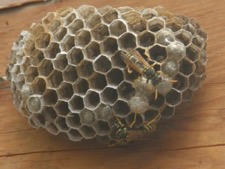
European Paper Wasp nest

European Paper Wasp. They are slender with long thin wings and measuring 10 – 15 mm
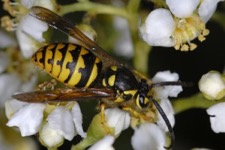
Yellow Jacket wasp
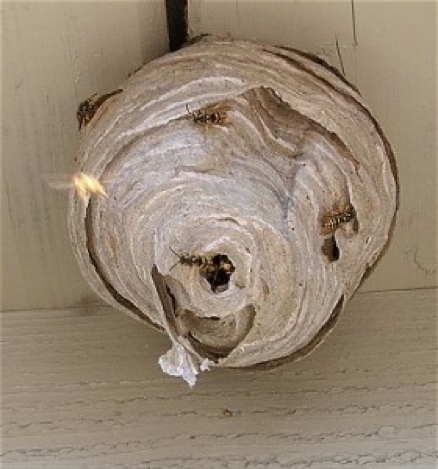
Yellow Jacket wasp nest
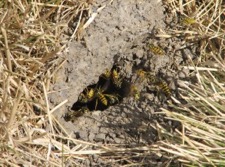
European wasp usually builds its nest underground or in a roof or wall cavity.
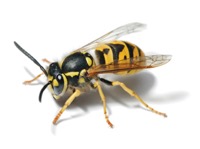
Worker Size 12-15 mm
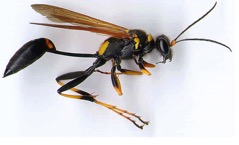
Mud Dauber Wasp
Members of this genus the Sphecidae are easily distinguishable from other mud-nest builders by the extraordinarily thin, straight, stalk-like first segment of the abdomen, also known as the petiole . They are of moderate to large size (body length 17-26 mm) and largely black but with some areas yellow. They hunt spiders of various kinds as food for their larvae. All are solitary, each female building and provisioning its own nest. These wasps are usually inoffensive although females will sting if handled
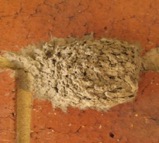
A slender mud dauber wasp and its nest on a brick wall.
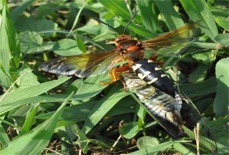
Cicada Killer Wasp
Size range
4 cm
Distribution
Cicada-killer wasps are found throughout Australia.
Habitat
Cicada-killer wasps are found in urban areas, forests and woodlands, and heath.
Feeding and Diet
Cicada-killer wasps hunt in the trees for cicadas, which feed on sap using their piercing mouthparts. Once found, the wasp quickly stings and paralyses its victim. The heavy burden is then flown or dragged to the wasp's underground nest where an egg is laid on it. Having provided its unhatched larva with fresh food, the wasp then seals the nest. Sometimes the cicada-killer wasp returns to the exact spot where it captured its prey to feed on the sap that now leaks from the hole made in the tree by the cicada.
Danger to humans and first aid
Cicada-killer wasps are large and have a potentially painful sting. However they are not aggressive and are very unlikely to use their venom on humans unless extremely provoked. The best advice is to leave them alone. An ice pack may be used to relieve the pain of the sting. If there is evidence of an allergic reaction, medical attention should be sought.
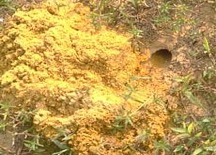
Cicada killer Burrow
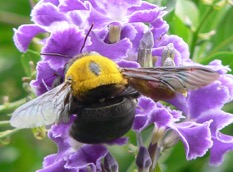
Carpenter bees
Appearance3/4 - 1 inch long.
Female faces are black, male faces are yellow.
Bright yellow, orange or white hairs on the thorax.
No hair on abdomen.
Females have a stinger, males do not.
LifecycleTunnel into wood to lay eggs.
Life cycle from egg – larva – pupa - adult takes approximately seven weeks.
Larva is large and noisy.
New adults emerge from the nest late August.
HabitsSting - Only sting if provoked.
Visibility - Late-spring to mid-October.
Nesting - Bare, untreated softwoods are preferred, including redwood, cedar, cypress and pine. Old nests are used year after year.
Location – Nests can be found in eaves, window trims, facia boards, siding, decks and outdoor furniture.
Feeding - flowers that contain pollen, eg Bradford’s, Daffodils, Pansies. Pollen stored in abandoned tunnels for overwintering.
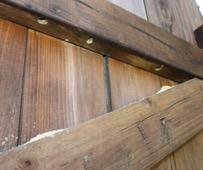
Carpenter bee and the nesting holes it’s made.
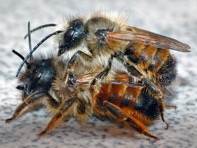
Mortar bees, or Masonry bee
Masonry bees and the holes they made in the structural wall
Mortar bees, or Masonry bees, are so called because they sometimes burrow into the mortar joints in brick walls or will occasionally use crevices in walls. There are a number of different species of bee that do this, but the most common has the scientific name of Osmia rufa. Appearance and life history In appearance these bees are not unlike ordinary honey bees, and share the same soft brown and yellow colouration, as opposed to the bright yellow and black of the wasp, which mortar bees are often confused with. However, all mortar bees are solitary and do not form the distinct social colonies that we associate so much with honeybees and common wasps, although they may be found close to each other since they exploit suitable nesting sites. The natural habitat of mortar bees is earth banks and soft exposed rocks into which the female bee burrows. She builds a series of tunnels or galleries in the spring in which to lay her eggs from which the new adults emerge in the spring. Only one such brood is raised each year. They will only be seen for a few weeks in the spring. Prevention The only effective way of preventing these bees is to repaint areas of soft and perished mortar as the bees can only burrow into comparatively weak materials. The joints should be raked out to a depth of 15mm (0.58in), and re-pointed with a mortar that is not too strong for the bricks, but hard enough to discourage the bees. Mortar bees will also lay eggs in old drilled holes in brickwork and gaps around window and doorframes. This work is best done in late summer, after the bees have ceased their activities but before the possibility of frost damage. Spraying or injecting insecticides does not have any lasting effect, and is only recommended in those rare cases where bricks or stonework have been entered. Mortar bees are not aggressive, they have a sting but are unable to pierce the human skin and are therefore harmless and more of a nuisance insect.
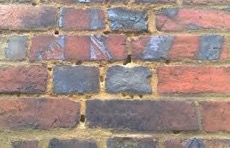
Masonry bees and the holes they made in the structural wall
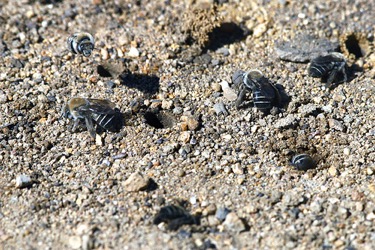
Mining bees
Mining or digger bees nest in burrows in the ground. Unlike the honey bee, mining bees are “solitary” bees. They do not form long-lived colonies, or live inside a single, well-defended nest controlled by one queen bee. Instead, each mining bee female usually digs her own individual burrow to rear her own young. Large numbers of these bees may nest close together if soil conditions are suitable. Mining bees are not aggressive and seldom, if ever, sting. The presence of numerous bees flying close to the ground, however, may constitute a nuisance for some people. Sometimes large numbers of males will fly about the same spot for several days in a mating display. Mining bees range in size from about the size of honey bees to much smaller. The larger bees are furry and usually darker in colour than honey bees. Some are brightly striped, while others are a shiny metallic green. Mining bee burrows may be located wherever there is exposed soil and good drainage.
What to Do if I have a Bee, Wasp or Hornet Problem?
Suspect you have a bee hive or wasp nest nearby? First, you should identify which insect is flying around your home. If you are sure that your house is being invaded by bees, you may choose to leave the situation alone as bees are generally harmless unless provoked. However, if you would prefer to eradicate the problem, you should not, under any circumstances, poke at a beehive or attack the bees without professional help. This may anger the bees and cause them to attack you or innocent residents that live near you as well. Instead, the best course of action is to contact us at Redknight to undertake this delicate task of removal.
What to do with the empty wasp nest when all wasp are dead now?
For peace of mind, we can return to remove the nest from your property; only after a minimum of 48 hours to allow complete treatment of the whole wasp colony (this extra visit will incur an additional charge). But removing the nest may not be possible if it's within a cavity wall or similar enclosed location.
We at redknight can safely relocate the bees.
Similarly, if you have a wasp or hornet problem, the best course of action is still to contact a pest control service. Disturbing a hornet or wasp nest may result in devastating consequences as these insects are very aggressive and would not hesitate to sting repeatedly. Their streamlined bodies allow them to fly at faster speeds than bees, but are still easy to outrun. Unfortunately, by the time you outrun them, you would have already received a few painful stings from them.
Why Redknight ?
As a leading company in pest control services, we are well-prepared to handle cases of bee infestations, hornet invasions and wasp control. Redknight engages a team of well-trained experts that understand the behaviours of these insects and are able to provide finely tailored solutions for every situation. Our industry professionals will solve your bee, hornet and wasp infestation problems with the most effective methods, leaving you satisfied with our high quality and affordable services and most importantly keeping your family safe.
Wasp & Bee removal experts in Melbourne , Geelong and Ballarat. All work comes with warranty.
